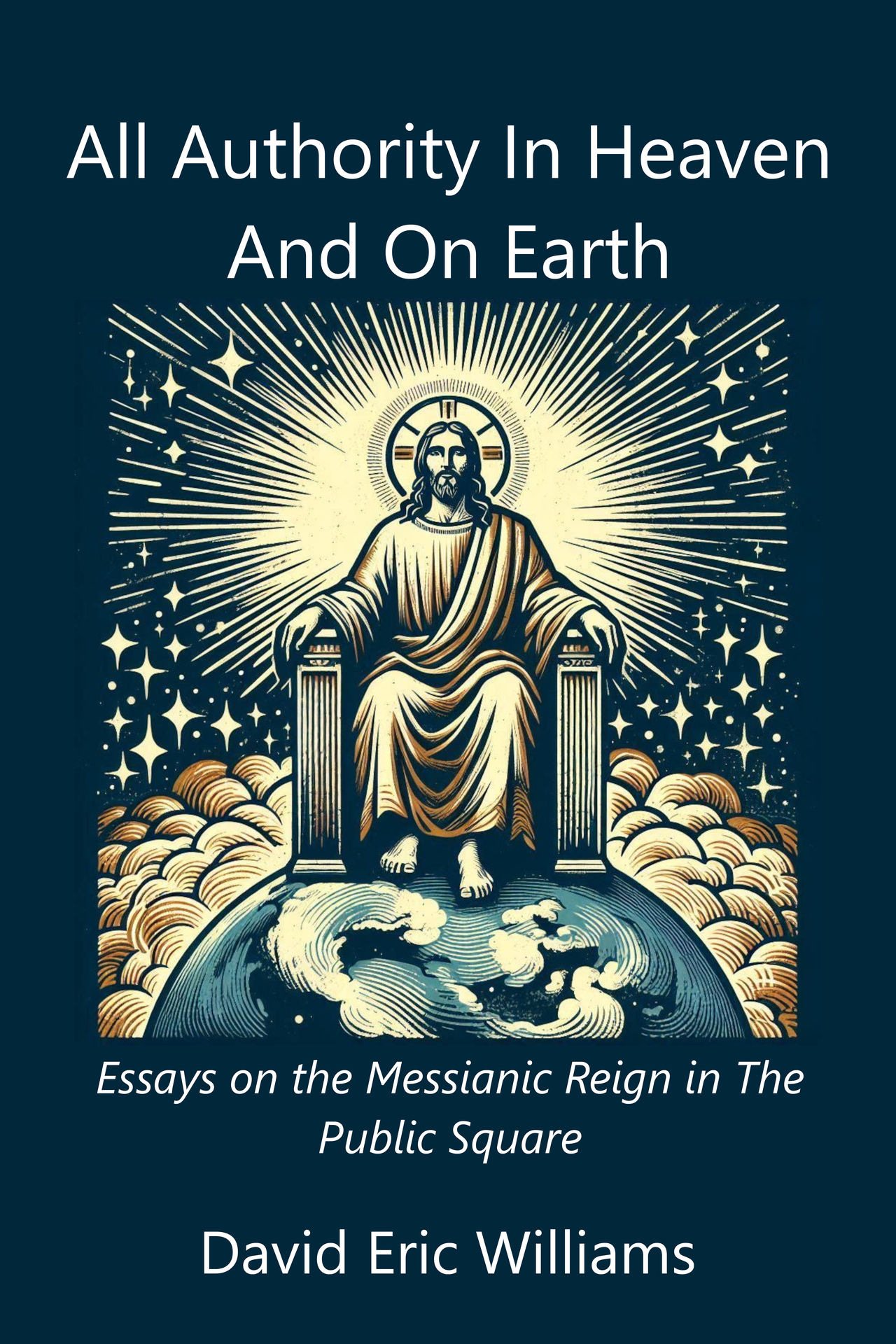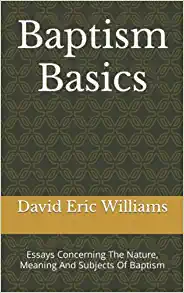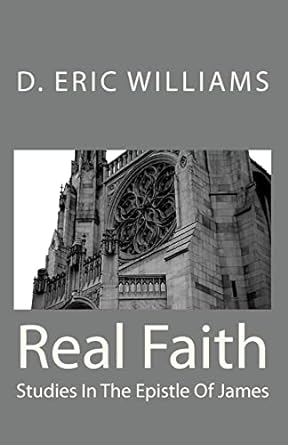Book Critique: Believer's Baptism, Sign of the New Covenant in Christ
© 05.22.19 By David Eric Williams
 The debate over credobaptism versus paedobaptism is centuries old. The book, Believer's Baptism Sign of the New Covenant in Christ,1 proposes an argument in favor of credobaptism that focuses upon the fundamental point of disagreement at issue in the baptismal debates: covenant theology. While the book strives to settle the argument in favor of credobaptism, it seems Believer's Baptism presents an argument best suited for the already convinced credobaptist. Thus Believer's Baptism fails to adequately clarify the discontinuity between the Old Covenant and the New Covenant and therefore leaves the question of credobaptism versus paedobaptism unanswered.
The debate over credobaptism versus paedobaptism is centuries old. The book, Believer's Baptism Sign of the New Covenant in Christ,1 proposes an argument in favor of credobaptism that focuses upon the fundamental point of disagreement at issue in the baptismal debates: covenant theology. While the book strives to settle the argument in favor of credobaptism, it seems Believer's Baptism presents an argument best suited for the already convinced credobaptist. Thus Believer's Baptism fails to adequately clarify the discontinuity between the Old Covenant and the New Covenant and therefore leaves the question of credobaptism versus paedobaptism unanswered.
Believer's Baptism, Sign of the New Covenant in Christ is edited by Thomas R. Schreiner and Shawn D. Wright. Schreiner (PhD Fuller Theological Seminary) is professor of New Testament Interpretation and Associate Dean of Scripture and Interpretation at The Southern Baptist Theological Seminary. Wright (PhD The Southern Baptist Theological Seminary) is Assistant Professor of Church History at The Southern Baptist Theological Seminary.2
Summary
The introduction clearly presents the aim of the book as a corrective concerning a specific error among evangelical paedobaptists: the belief that "baptism brings the child into the covenant community where he or she will have the blessing of hearing the gospel preached as they grow up as members of the church."3 Thus, the entire book is written to refute the Reformed view of covenant theology an idea that it is right to apply the sign of faith in Jesus to those who have not publicly articulated faith, specifically infants.4
Prior to an examination of covenant theology the book surveys how baptism is presented in the Gospels5, Acts6 and the epistles.7 This is not so much to prove credobaptism but to show that the gospels and letters of Paul indicate that the recipients of baptism must be able to intelligently affirm the meaning of the rite.
Once Believer's Baptism turns to consider the issue of covenant theology, it states that "the Reformed doctrine of infant baptism is the argument that it is an implication drawn from the comprehensive theological category of the 'covenant of grace.'"8 It is in this particular essay that the book pulls together the primary argument against paedobaptism and in favor of credobaptism.
The next two essays delve into church history followed by an essay concerning "the logic of reformed paedobaptists"9 and a critique of Meredith Kline's application of the suzerain treaty model to baptism.10 The book concludes with a survey of Baptistic beliefs in the Stone-Campbell Restoration Movement and the place of baptism in the life of the local church.
Critique
Each of the essayists writing in Believer's Baptism consider the question of credo versus paedobaptism from the point of view of confessional baptists. Each writer clearly conveys their conviction that baptism must be preceded by repentance and faith and that the subjects of baptism must be of an age able to convincingly articulate faith in Jesus Christ alone for salvation.
Thus, the book was written to substantiate the practice of credobaptism and to bolster the confidence of Baptists in their particular theology. This is accomplished through the exegesis of Scripture, the study of history, the critique of paedobaptists theology and a closing word of practical theology.
Yet the question of whether the authors have proven their point really depends upon the presuppositions one brings to the subject. Recall, the primary intent of the book was to refute the covenant theology of the Reformed faith.11 Moreover it is acknowledged by the authors that Reformed paedobaptists view covenant theology as the lynch-pin of biblical interpretation; it is impossible to properly understand the Bible without an understanding of covenant.12 Hence, the entire argument of the book rests upon a particular interpretation of the Bible, all supported by empirical examples provided by Scripture itself. In other words, the authors endorse Believers baptism based upon a particular interpretation of the New Covenant and claim the accuracy of their interpretation is supported by the examples of Believers baptism found in Scripture. It seems the arguments of the book will be readily accepted by those already convinced that credobaptism is biblical while paedobaptism is not; the authors are preaching to the (Baptist) choir.
The strongest point of the book is found in the examinations of baptism in the New Testament. As the book points out, there is not one example of infant baptism in the Bible. This of course is a strong counter to the "argument of silence" suggesting that there are no examples of infants being denied baptism.
Although the primary purpose of the book is to refute the Reformed view of covenant theology or the "covenant of grace" It does not seem the authors succeed in this endeavor. For instance, the book inadequately deals with the declaration of Galatians 3:29, "And now that you belong to Christ, you are the true children of Abraham. You are his heirs, and God’s promise to Abraham belongs to you."13 To simply say "in baptism we become part of Christ and become heirs to the eschatological promises made to Abraham"14 is more assertion than argument.15 In other words, the assertion that New Covenant Believers are heirs only to the "spiritual" or eschatological aspects of the Abrahamic covenant is not adequately supported from Scripture. On the other hand, "since the Galatian believers are 'in Christ' and since Christ is the seed of Abraham (v. 19), then it follows that the Galatian believers are also Abraham's seed. If they are Abraham's seed, then they also inherit Abraham's promise - a relationship with God that entails his blessings and goodness."16 Paul's argument is that a person "aligns himself with the central event of salvation history and partakes of the benefits accruing therefrom."17 That is to say, the one who is in Christ immediately partakes of the "benefits accruing" from the Abrahamic covenant. This includes the promise that "I will confirm my covenant with you and your descendants after you, from generation to generation. This is the everlasting covenant: I will always be your God and the God of your descendants after you" (Genesis 17:7). It is generally agreed that this verse means what it says: the Abrahamic covenant provided an everlasting promise of salvation to Abraham and his descendants.18 According to Paul, Jesus Christ is Abraham's Seed and all those found in him are heirs according to the promise. Thus "we believe that God will be a God to us but doubt that he will be a God your descendants after us. Both promises should be embraced by a living faith."19 The essayists writing in Believer's Baptism failed to adequately address this concern.
Moreover, the authors suggest "Reformed paedobaptists pay inadequate attention to the NT's interpretation of the 'newness' and the 'betterness' of the new covenant (Heb 8:6)."20 However, the book fails to answer the question why a better covenant with better promises would eliminate a whole class of people from the blessings of the covenant. Indeed, the introduction of the Gospel in Luke's account proclaims that one of the better aspects of the new covenant would be a strengthening of the relationship between parents and their children rather than a seperation.21
Concerning this same issue, the book fails to address the convictions of Jewish converts in the historical context of the New Testament. In other words, none of the essayists explain why first century Jews would have embraced a dramatic reduction in grace as a "better covenant with better promises." For, it cannot be disputed that the first century Jew strongly believed the covenant relationship he enjoyed with Yahweh was for he and his children (Genesis 17:7). If the reader is to believe the first century Jew would have interpreted Peter’s words differently - "This promise is to you, to your children" (Acts 2:29) - then there must be a convincing argument produced from Scripture. The authors of Believer's Baptism fail to make a convincing argument.
To continue along this line, Believer's Baptism fails to say why the New Testament does not provide an explanation concerning the dramatic reduction in the reach of the New Covenant. The reader is reminded throughout the entire book that the New Covenant is entered by confession of faith but the essayists fail to explain how this is essentially different than the Old Covenant. For, "Circumcision was a sign that Abraham already had faith and that God had already accepted him and declared him to be righteous - even before he was circumcised. So Abraham is the spiritual father of those who have faith but have not been circumcised. They are counted as righteous because of their faith" (Romans 4:11). The essayists suggest this passage refutes the theology of infant baptism since it speaks of conscious, intelligent faith followed by a sign of covenant inclusion.22 However, the paedobaptists agree with this - and go on to point out that on the basis of Abraham's faith, his offspring where counted as covenant members and received the same sign of faith and covenant inclusion.
This omission seems to suggest that the essayists writing in Believer's Baptism believe the first century Jews who turned to Christ where expected to abandon a primary tenet of their covenant relationship with Yahweh - without explanation. Therefore, possibly the weakest point of the book is the failure to tell why there is nothing in the New Testament explaining the less gracious character of the New Covenant concerning the children of Believers. Perhaps the authors felt this needed no explanation as it is considered an argument from silence. Nevertheless, an honest appraisal of second Temple Judaism and the expectations of those Jews who turned to Jesus as Messiah in the first century demand an accounting.
Conclusion
Believer's Baptism is an adequate resource for credobaptists seeking sound Baptist scholarship in support of their theological convictions. The book is thorough, touching on all questions that may arise for the credobaptist when confronted with the opposing theological convictions of their evangelical paedobaptist friends. The book would be valuable as a resource in the "newcomers class" in the ministry of the local Baptist church.
However, Believer's Baptism falls short as a treatise designed to convince paedobaptists of error. Since the book made the refutation of the evangelical Reformed view of covenant theology the center of its argument, a more thorough disproof is in order. Thus, it is unlikely Believer's Baptism will change the mind of a convinced paedobaptist. Instead, Believer's Baptism will most likely serve to reinforce the paedobaptistic convictions of Reformed evangelicals. From the perspective of one who moved from credobaptist to paedobaptist convictions, Believer's Baptism actually highlights the inadequacy of the confessional baptists argument concerning the nature of the New Covenant and its relationship to the children of Believers.
Additionally, the book claims that confessional baptism largely eliminates the problem of unregenerate church members. In the experience of this reviewer in over 30 years of ministry, this isn't true. The truth is, the "holistic theology" of Reformed evangelical doctrine properly understood and taught is the best defense against baptized yet unregenerate church members. Thus, for this reviewer, Believer's Baptism fails to support the credobaptist contention that the discontinuity between the Old and New Covenants requires baptism of adult believers on confession of faith - and the exclusion of their children.
_________________________
1. Thomas R. Schreiner and Shawn D. Wright, eds., Believer's Baptism: Sign of the New Covenant in Christ, (Nashville, TN: B & H Academic, 2006).
2. Ibid., back cover.
3. Believer's Baptism, 7.
4. Ibid.
5. Andreas J. Kostenberger, "Baptism in the Gospels," Believer's Baptism, 11.
6. Robert H. Stein, "Baptism and Luke-Acts," Believer's Baptism, 36.
7. Thomas R. Schreiner, "Baptism in the Epistles: An Initiation Rite for Believers," Believer's Baptism, 67.
8. Stephen J. Wellum, "Baptism and the Relationship between the Covenants," Believer's Baptism, 97.
9. Shawn D. Wright, "Baptism and the Logic of Reformed Paedobaptists," Believer's Baptism, 207.
10. Duane A. Garrett, "Meredith Kline on Suzerainty, Circumcision and Baptism," Believer's Baptism, 256.
11. Believer's Baptism, 7.
12. Wellum, "Covenants," Believer's Baptism, 97.
13. All Scripture quotations are taken from the New Living Translation unless otherwise noted.
14. Schreiner, "Believers," Believer's Baptism, 89, emphasis added.
15. A. B. Caneday quotes Beasley-Murray to this effect, albeit in a different context: A. B. Caneday, "Baptism in the Stone-Campbell Restoration Movement," Believer's Baptism, 308.
16. Scot McKnight, Galatians, The NIV Application Commentary, ed. Terry Muck, (Grand Rapids MI: Zondervan Publishing House, 1995), 202-203.
17. Ronald Y. K. Fung, The Epistle to the Galatians, The New International Commentary on the New Testament, ed., Gordon D. Fee, (Grand Rapids, MI: William B. Eerdmans Publishing Company, 1988), 178.
18. John H. Walton, Genesis, ed. Terry Muck, vol. 1, 24 vols., The NIV Application Commentary (Grand Rapids, MI: Zondervan, 2001), 450.
19. Edward N. Gross, Will My Children Go to Heaven? Hope and Help for Believing Parents, (Phillipsburg, NJ: P & R Publishing, 1995), 25.
20. Wright, "Logic," Believer's Baptism, 207.
21. Douglas Wilson, To A Thousand Generations: Infant Baptism, Covenant Mercy for the People of God, (Moscow ID: Canon Press, 1996), 15.
22. Wellum, "Covenants," 154-155, Believer's Baptism. See also, Schreiner, "Believers," 86.
Entire Site Copyright © 2025 By David Eric Williams










